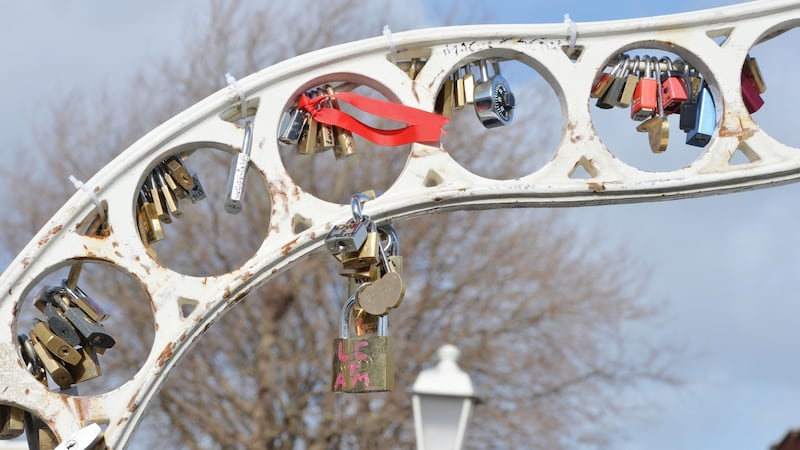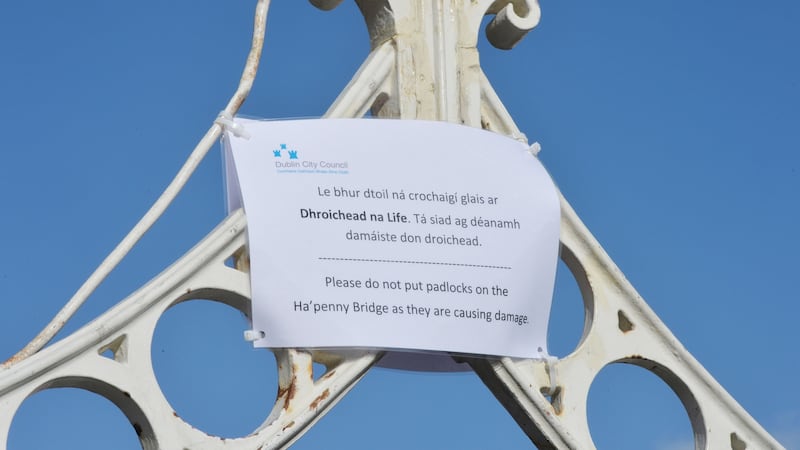The issue of so-called love locks being placed on bridges over the river Liffey comes up in Dublin City Council so often that one official considered changing his computer login password to "love locks", correspondence released under the Freedom of Information Act shows.
In 2014, a railing on the Pont des Arts in Paris collapsed under the weight of hundreds of thousands of padlocks which had been placed on it by members of the public. According to one estimate the “love lock” phenomenon exists in about 25 countries.
Email correspondence shows Dublin City Council has recently considered erecting a sculpture on the quays specifically to attract the locks away from the nearby Ha’penny Bridge. It has also asked a local retailer to be careful about selling locks to the public.
Couples typically place the locks on bridges – the Ha’penny Bridge attracts most of them in Dublin, but they’re also on the Samuel Beckett Bridge and a couple of others – as a symbol of their love. But the locks damage the structures and, as the council pointed out in an email, there is “also a problem in the river with the volume of keys being thrown in”.

Attempts to address the issue have been frustrating, it would appear.
On March 7th, 2019, Dublin City Council public domain officer Dominic Hession said he spoke to the waste management department and there “is little or nothing we can do about the shop selling padlocks”.
Have a very good campaign so that social media is used to inform that 'love-locks' on the Ha'penny Bridge will be removed
In an email the following day, Dublin City Council senior executive engineer Patsy Gorman said he tried to get a sculpture set up and had meetings with several council bodies but “it came to nothing as no one took ownership of the project”.
Sculpture for locks
In an email on March 14th, Mr Gorman said the padlocks problem comes up frequently. “The ‘love lock’ issue is on my desk so often that I am thinking of changing my log-in password to ‘love locks’.”
He also elaborated on the idea of putting up a sculpture for the locks and outlined how this should happen. “1. Agree a site/location for a ‘sculpture piece’. 2. Prepare many sketches and/or have a competition so that the public can make submissions. 3. Have a very good campaign so that social media is used to inform that ‘love-locks’ on the Ha’penny Bridge will be removed but those on the sculpture will be maintained so you can call it the ‘love dock’”.

He added: “I did get an email from a member of the public who complained about the locks on the Ha’penny Bridge but later he offered to sell locks beside a ‘sculpture piece’ if DCC erected it so there are ideas out there.”
He continued: “I was thinking of selling locks that all open with a master key. The issue is in approx 25 countries and I think [one city] got a sculpture tree erected to deal with the issue.”
Lock retailer
Council chief executive Owen Keegan had earlier asked that three issues might be considered: whether signs should be erected; whether the locks should be removed more frequently; and whether a local retailer could stop people buying locks to attach to the bridge.
Mr Gorman said one public representative had got in touch to ask for signs to be erected and, after they were put up, another got in touch to ask that they be taken down. “We tried signs and they didn’t work,” he said.
Mr Gorman said the council had just entered into an arrangement with a contractor to remove the locks every two weeks, rather than three or four times a year as previously. “So we have to see how this goes.”
He added that Mr Hession had called into a retailer who had a variety of padlocks on display. “I told him the situation with regard to the removal of the padlocks and asked that he desist from selling padlocks if the customer indicated that it is to be used on a bridge.”








